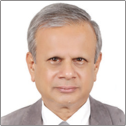Translate this page into:
Editor’s Page

*Corresponding author: P. S. N Menon, Department of Pediatrics, Jaber Al-Ahmed Armed Forces Hospital, Kuwait City, Kuwait. psnmenon@hotmail.com
-
Received: ,
Accepted: ,
How to cite this article: Menon PS. Editor’s Page. J Pediatr Endocrinol Diabetes 2022;2:99-100.
It is our pleasure to welcome the new team of office-bearers of ISPAE. The team for the next 2 years will be led by Dr. Ahila Ayyavoo from Coimbatore, India as the President with Dr. Rakesh Kumar, Chandigarh as Secretary-cum-Treasurer, and Dr. Sirisha Kusuma as the Joint Secretary. We welcome the new executive council members and the editor of our official newsletter, the Capenews, Dr. Aashima Dabas and our website manager, Dr. Mahesh Maheshwari to the team.
There are scanty reports of children with Laron syndrome (LS) from India. In this issue, Rajalakshmi et al. from Chennai provides a descriptive study of five children with LS from South India. The diagnosis was confirmed by genetic testing as a mutation in growth hormone receptor (GHR) gene in two children. Severe postnatal growth failure and a characteristic facies were present. LS should be suspected in children with clinical features of growth hormone deficiency along with elevated growth hormone (GH) levels and low insulin-like growth factor 1(IGF-1) levels with no increment in the IGF-1 generation test. LS is an autosomal recessive disorder common in consanguineous families with up to 70 mutations described in the GHR gene. Different phenotypes of the same mutation and within the same family have been described. This study highlights the importance of genetic testing and genetic counseling in children and carriers suspected of GHR gene mutation.
In an invited editorial commentary, Prof. Ram K. Menon, Michigan, USA highlights the global issues in the diagnosis and management of LS. LS is the prototypic primary GH insensitivity syndrome (GHIS), which may be due to mutations in the GHR gene or post-receptor defects. GHIS is the most common and well-studied entity causing LS, with severe deficiencies of IGF-1, IGF-binding protein 3, and acid-labile subunit. The most common genetic defect in LS involves the extracellular domain of the GHR and manifests with severe phenotypes. Children with LS have high circulating levels of basal and stimulated GH, and serum IGF-1 is low and does not rise on administration of exogenous GH. GH-binding protein (GHBP), another marker is usually low, but normal levels do not rule out a diagnosis of LS. Genetic tests are thus confirmatory. Recombinant human IGF-1 (rhIGF-1) is approved by the US Food and Drug Administration since 2005 for treatment of LS. Growth response with rhIGF-1 treatment is less compared to that observed in severely GH-deficient children receiving GH replacement, and generally, children with LS are unlikely to reach adult heights in the normal range. Prof. Menon highlights need for a registry for GHIS in India. He cautions about the dose-response relationships of rhIGF-1 therapy in LS and the need for a meticulous follow-up.
In another editorial commentary, Prof. Sudha Rao, Mumbai, India looks at the profile of GHIS in India, which is mostly limited to description of clinical profile and diagnosis. The cardinal feature of LS is severe post-natal growth failure and often these children are labeled as idiopathic short stature. Patients with LS show low or undetectable GHBP levels, but normal GHBP levels are insufficient to exclude the diagnosis of LS. The protocols for performing IGF-1 generation test have not been standardized and the levels of IGF-1 achieved are quite variable. A scoring system to identify patients with GHI has been suggested. Prof. Rao comments on the limited experience of rhIGF-1 therapy in India and on the prohibitive cost of rhIGF-1 therapy in India.
Congenital hypothyroidism is the most common preventable cause of intellectual disability in the world. Early diagnosis and treatment are the key elements to prevent neurodevelopmental delay in children with CH. In an original article, Dr. Anshika Singh et al. from Bengaluru, India have described the neuromotor and neurocognitive developmental profile of children with congenital hypothyroidism at 18–42 months of age and correlated it with initiation and duration of treatment as well as normalization of thyroid-stimulating hormone (TSH) levels post-replacement therapy. Neurodevelopmental retardation was detected in children in whom time taken for normalization of TSH was longer. The authors have recommended that we should work toward making newborn screening universally available in India so that treatment can be initiated early in life.
In an accompanying editorial commentary, Vibha Yadav and Anurag Bajpai, Kanpur, India state that initiating treatment in the first month of life at a high dose with rapid normalization of thyroid functions and good adherence to therapy are the key determinants of good long-term development outcome in congenital hypothyroidism. There is a paucity of data regarding the neurodevelopmental outcome of congenital hypothyroidism in Indian children. The current observations highlight the importance of initiating therapy at a thyroxine dose above 10–15 µg/kg/day in the newborn period and by 14 days of life. This, however, needs to be balanced by avoiding overtreatment.
This issue also has some unusual but interesting case reports.
In our regular feature on Pediatric Endocrinology Journal Scan, Kriti Joshi, Brisbane, Australia discusses on recent publications on once-weekly Semaglutide therapy for adolescent obesity, bionic pancreas in type 1 diabetes, gonadoblastoma in Turner syndrome, and monogenic hyperinsulinemic hypoglycemia in childhood. We do hope that these articles are stimulating for the young readers especially postgraduates.
In the Fellow’s Corner in this issue Sayan Banerjee, Chandigarh, India writes about the options and aspirations of a budding pediatrician who has chosen to follow a career in pediatric endocrinology. We hope that his dream of seeing departments or divisions of pediatric endocrinology at every major academic institution nationwide is realized soon.
Wish you all a happy reading!





